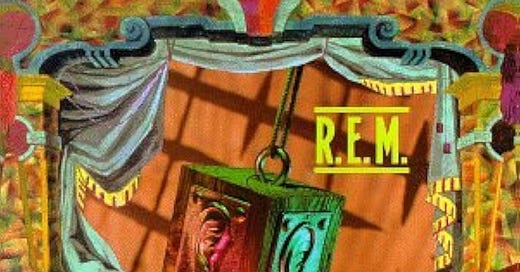The 1985 Project Part 7: R.E.M. Fables of the Reconstruction
This was their third full-length album - seems like it came later
This is the place where I look back at the albums of 1985, starting with the 40 top finishers in that year’s Village Voice Pazz & Jop Poll of critics with plans to talk about other records that came out 40 years ago.
R.E.M. – Fables of the Reconstruction. By 1985, I was pretty sure R.E.M. was one of the greatest bands in the world. Hoo boy, would I ever change my mind about a dozen times in the 40 years after that. But after Chronic Town, Murmur, and Reckoning spent about a zillion hours on my turntable in the three years before this one came out, I was pushing hard for R.E.M. to achieve the mammoth success I felt they were owed (and which they would achieve in just a few more years).
Fables was different from the previous albums. Obviously, bringing the legendary producer Joe Boyd on board instead of working with their less experienced peers Mitch Easter and Dixon made for an immediate change in sonic approach. The songs were still built around guitarist Peter Buck’s mastery of arpeggiated chord changes, giving vocalist Michael Stipe inspiration for unusual yet delightful melodies. But Boyd didn’t make the guitars as prominent as on the first two albums, giving Mike Mills on bass and Bill Berry on drums a bigger presence. There was also more space between the instruments, making the sound a little darker, a little more mysterious.
Buck’s opening guitar lick in “Feeling Gravity’s Pull” was darker and more mysterious, too. It was the first sound on an R.E.M. record that didn’t harken back to basic guitar/bass/drums rhythm approach. As the song progressed, a string quartet joined in at times, further pulling the band outside the template of the first albums. Michael Stipe was still a part of the band sound as much as he was a frontman. But phrases were jumping out – “It’s a Man Ray kind of sky / Let me show you what I can do with it.”
The rest of the album doesn’t have as big a change in song structure or arrangements but retains the less bright and jangly sound to keep the feel of Fables as something different from the past. Maybe “Driver 8” comes closest to sounding like what at that point was classic R.E.M. – I suspect Easter might have brightened it up with a piano under it but I like the focus of Mike Mills’ hard-edged bass here. It’s certainly as catchy a tune as anything they’d produced to that point, which is to say it’s pretty darned catchy.
I haven’t pulled out this record in a long, long time, and it was quite pleasurable to revisit something I’d once loved. I’m not sure that it holds up as well as some other records by R.E.M. – I probably still love Murmur and Automatic For the People the most. Most of side two, with the exception of “Wendell Gee,” seems to reveal cracks in the foundation of the band’s approach to songwriting which would explode in the much more creative Life’s Rich Pageantthe next year.
The three youngest bands in the top ten of 1985’s Pazz and Jop Poll – the Replacements, Hüsker Dü, and R.E.M. – were all seen at the time as bringing major generational change to rock music. I bought into that hook, line, and sinker, wanting these bands specifically, and others just as inventive and full of personality, to take over the pop charts. The critics who were voting in Pazz and Jop in 1985 were probably at least partially influenced by this desire. I’m not saying they inflated their votes – the reason we all wanted these bands to succeed was that they genuinely did thrill us.
I guess this is probably worth 7.5 points out of 10.



